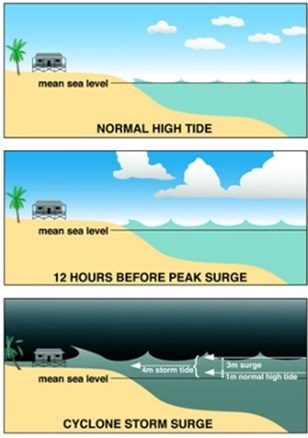Tropical cyclones produce dangerous winds and heavy rainfall, increasing the risk of floods and storm surge.
Wind
As a cyclone approaches the coastline, the force of the wind will progressively increase. This wind is capable of an intensity powerful enough to uproot large trees and blow away unsecured sheds.
Heavy rainfall
Where flooding is a risk, the heavy rain associated with a cyclone can overwhelm waterways. The flooding that results is frequently widespread, not just local to the area of direct impact.
Storm surge
The extreme winds a cyclone produces at sea, 'pushes' the coastal tide inland. The resulting surge of water floods low lying inland regions. This is most dangerous at high tide. During tropical cyclone Vance (1999), Exmouth Western Australia, the storm surge peaked at 4.9 meters above the predicted tide level of 1.4 meters. Storm surge has been responsible for more deaths than any other feature of tropical cyclones.

From sea to shore (Bureau of Meteorology, 2015)
Eye of the storm
When the eye of a cyclone make landfall, a temporary lull in the wind and rain will occur. Following which will be a second peak as the remainder of the cyclone passes through. Slow moving cyclones can take up to 12 hours to transverse a location.